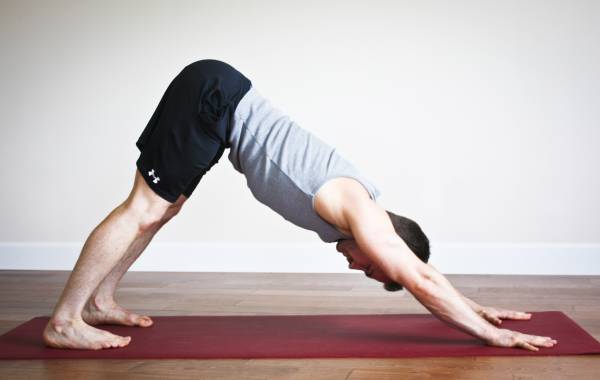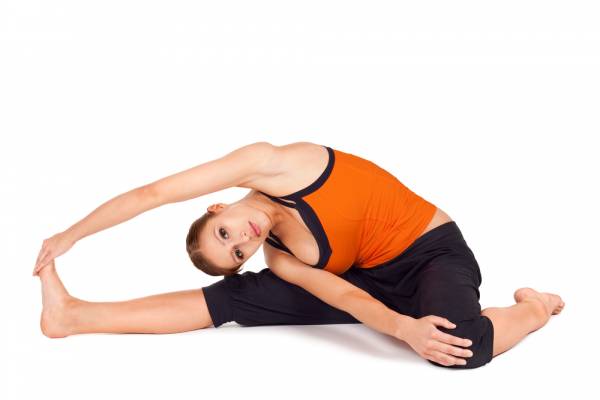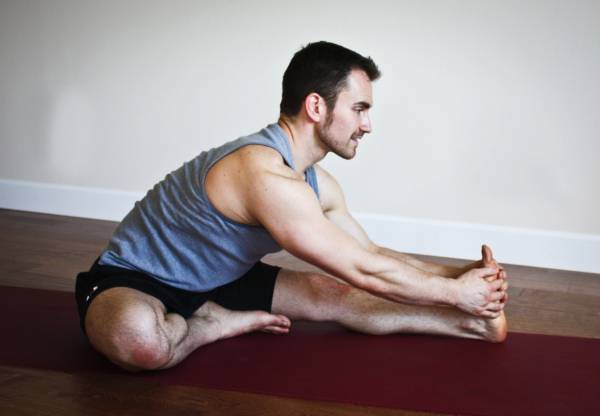One of the first anatomy lessons we learn in yoga training is on internal and external rotation of the hip and shoulder joints. In the vast majority of yoga poses, the shoulders rotate externally. In fact, there are just a few weight-bearing poses where the shoulders are in internal rotation. This is because the shoulder joint is more stable when externally rotated and firmly engaged.
The same goes when lifting in the front rack position. Getting the shoulders to externally rotate, plug into the sockets, and engage will keep them safe when a load is added. Here are some tips to help learn external rotation and mobilize key parts of the body required for the front rack position.
Triceps Mobility in External Rotation and Front Rack
When the arms are lifted above the head with the palms turned in, the shoulders should be in external rotation. However, it is possible to just rotate the wrists without rotating the shoulder. The real indicator is the triceps wrapping forward. In yoga we call this “closing the armpit.” Try it yourself. Reach the arms over the head, turn the palms in, and try to close your armpit as much as possible rather than allowing it to shine forward. You probably won’t see much change, but the feeling of going toward this position will wrap your triceps forward and externally rotate the shoulder.
 A great pose to help feel this is downward facing dog. It can be challenging to externally rotate the shoulders as the palms cannot rotate here. Instead, all the rotation will come from a sensation of hugging the forearms in, wrapping the triceps down, aiming to close the armpit as much as possible, but staying engaged in the bicep in order to avoid hyperextension in the elbow. Just holding this position will strengthen the shoulder in external rotation.
A great pose to help feel this is downward facing dog. It can be challenging to externally rotate the shoulders as the palms cannot rotate here. Instead, all the rotation will come from a sensation of hugging the forearms in, wrapping the triceps down, aiming to close the armpit as much as possible, but staying engaged in the bicep in order to avoid hyperextension in the elbow. Just holding this position will strengthen the shoulder in external rotation.
If triceps mobility is lacking, try a triceps stretch on a chair or on two yoga blocks. Come to all fours with the hips over the knees. Place the triceps, just above the elbow, on the edge of a chair or two yoga blocks. Take your hands into prayer and lift the prayer up toward the sky, dropping your head down between your upper arms. Try to release the chest down toward the ground, but stay engaged in the lower belly.
Trunk Mobility in Front Rack
Most strength athletes I see have limitations on the mobility of the thoracic spine, which can be helped by opening the laterals and intercostal muscles. Both are large muscle groups running down the trunk. The laterals are the largest muscles in the back, while the intercostal muscles are small but make up the entire support structure for the lungs and rib cage. You will likely feel the intercostals stretch anytime you stretch your triceps, but you can take things a step further with some poses targeted at this area.
 Gate pose (parighasana) is my favorite pose to stretch the trunk. Come seated with the right leg extended and the left knee bent. Fold the left foot into the right inner thigh or, if it is more comfortable, bend the knee back like a hurdler. Grab hold of the left thigh with the right hand. As you inhale, sweep the left arm up, externally rotating the shoulder and softening the trapezius away from the ear. Exhale, side bend, reaching for the right foot with the left hand. If you cannot touch your toes, use a strap or a band to hook the foot. With each inhale, back off just a touch, rotating the chest toward the sky. With each exhale, fold in deeper. You may feel your hamstrings stretching, but we are going for a stretch in the side body.
Gate pose (parighasana) is my favorite pose to stretch the trunk. Come seated with the right leg extended and the left knee bent. Fold the left foot into the right inner thigh or, if it is more comfortable, bend the knee back like a hurdler. Grab hold of the left thigh with the right hand. As you inhale, sweep the left arm up, externally rotating the shoulder and softening the trapezius away from the ear. Exhale, side bend, reaching for the right foot with the left hand. If you cannot touch your toes, use a strap or a band to hook the foot. With each inhale, back off just a touch, rotating the chest toward the sky. With each exhale, fold in deeper. You may feel your hamstrings stretching, but we are going for a stretch in the side body.
 Move from gate pose to head-to-knee pose (janu sirsasana). Remain seated with the right leg extended. Inhale to raise both arms over the head. As you exhale, rotate your chest toward the right leg, then fold forward, reaching for the foot or strap. If you reach your left hand toward the outer right foot, you will feel the stretch in the left side of your back – the lats. Switch sides, doing each pose on both sides for 2-3 minutes.
Move from gate pose to head-to-knee pose (janu sirsasana). Remain seated with the right leg extended. Inhale to raise both arms over the head. As you exhale, rotate your chest toward the right leg, then fold forward, reaching for the foot or strap. If you reach your left hand toward the outer right foot, you will feel the stretch in the left side of your back – the lats. Switch sides, doing each pose on both sides for 2-3 minutes.
A simple message from this week’s session in the Mobility Movement at CrossFit 626 really stuck with me. These postures are not about changing results in your body but rather about changing habits. Learning to keep the shoulder externally rotated and allowing the trap to come away from the ear and give your neck space will protect the shoulder in lifts. It will also help keep the neck happy. Practicing this correction routinely in a yoga class in nearly every position builds a great habit for strength athletes to take with them into the gym. Like anything else, increasing your mobility will take practice. Be disciplined enough to either stretch every day on your own or attend a yoga class several times a week.
Photos 1 coursty of CrossFit LA.
Photos 2&4 courtesy of Brandon Hofer and Pulse Beat Fit.
Photo 1 courtesy of Shutterstock






